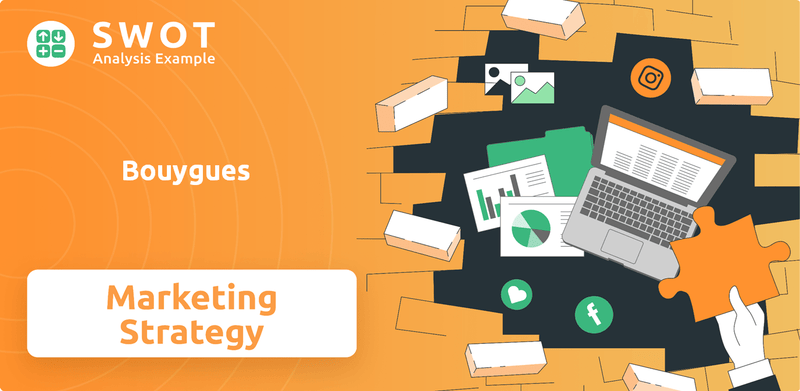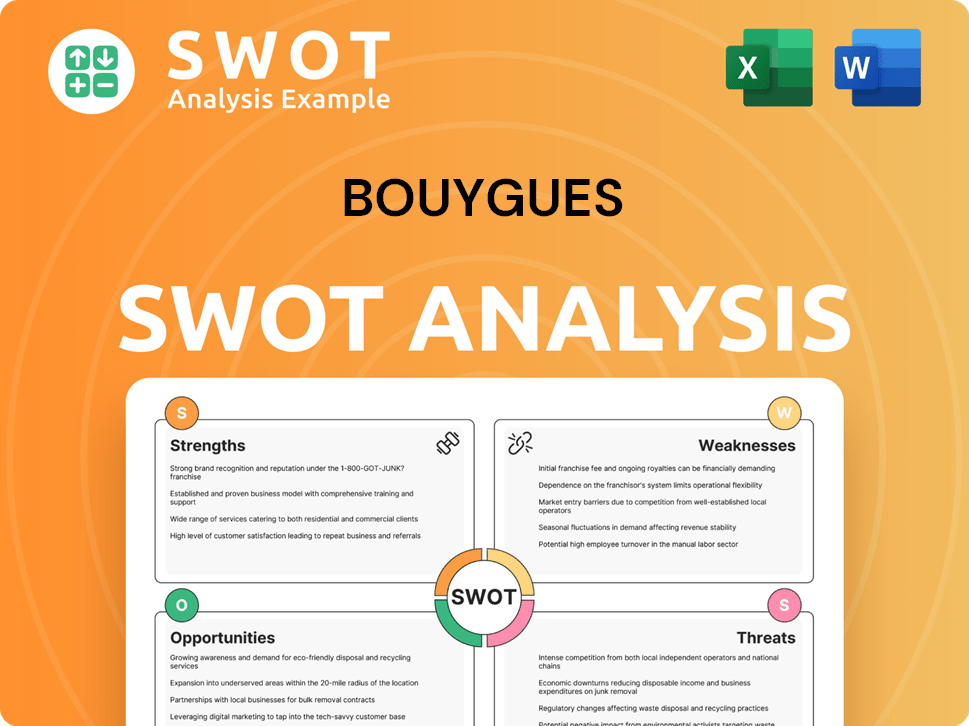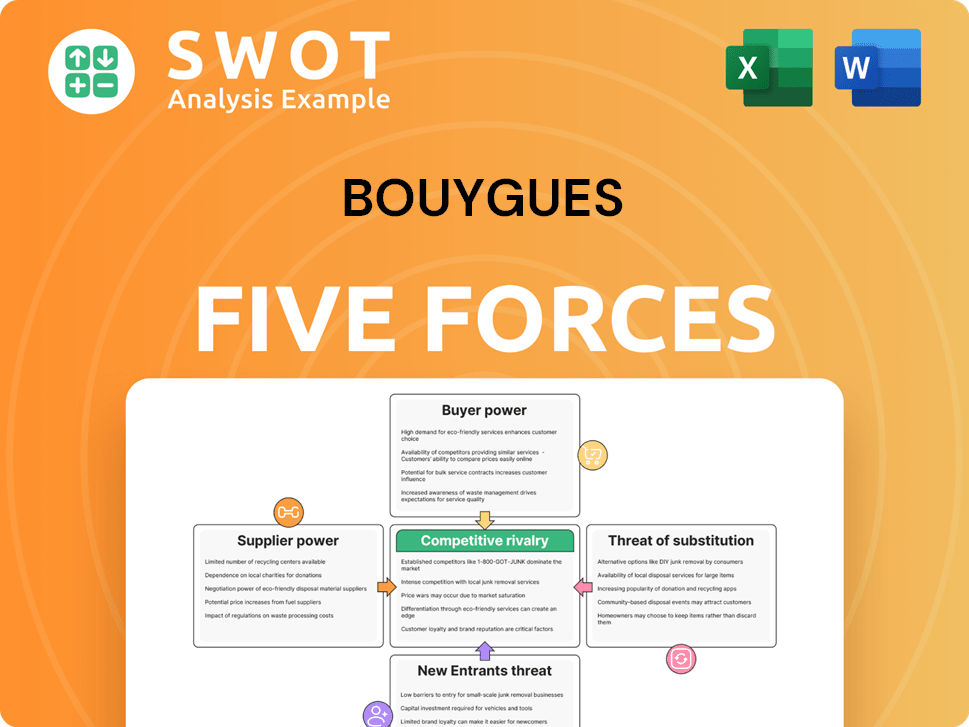Bouygues Bundle
How Does Bouygues Thrive in a Dynamic Market?
Founded in 1952, Bouygues has transformed from a construction firm into a global powerhouse, spanning construction, media, and telecommunications. Its commitment to innovation and sustainability, encapsulated in its vision to 'Make progress become a reality,' has driven its expansion. This diversification, with key subsidiaries like Bouygues Telecom, showcases its resilience and adaptability in a competitive landscape.

From its early focus on public works to its current multi-branded strategy, Bouygues' Bouygues SWOT Analysis reveals a complex interplay of market forces. Understanding the Bouygues sales strategy and Bouygues marketing strategy is crucial to grasping its success. This analysis will delve into the Bouygues company strategy, examining its Bouygues business model, conducting a Bouygues market analysis, and pinpointing its Bouygues competitive advantage to offer actionable insights.
How Does Bouygues Reach Its Customers?
The sales and marketing strategy of Bouygues involves a multifaceted approach, utilizing a blend of online and offline channels to reach its diverse customer base. This strategy is crucial for supporting its operations in construction, media, and telecommunications. The company's focus on digital adoption and omnichannel integration is evident across its various business segments, reflecting a forward-thinking approach to market dynamics.
Bouygues's sales channels are strategically aligned with each sector's specific needs, from direct sales in construction to a robust online presence and retail locations in telecommunications. This integrated approach allows Bouygues to effectively target different market segments and customer preferences. The company leverages its channels to drive sales growth and maintain a competitive edge in a dynamic market.
The company's sales channels and marketing efforts are designed to optimize customer reach and engagement, with a strong emphasis on digital platforms and strategic partnerships. This comprehensive strategy supports Bouygues's overall business objectives and contributes to its market performance.
In the construction sector, Bouygues primarily uses direct sales teams and project-based contracts. Bouygues Construction operates globally, with a presence in over 80 countries. In 2024, 62% of its €10.3 billion sales were generated outside France.
Bouygues Telecom employs a multi-channel approach, including its website and mobile apps. It also operates 519 physical retail stores in France. Partnerships with brands like B&YOU and Cdiscount Mobile expand its reach. In February 2025, a partnership with RELEX Solutions was established to optimize supply chain efficiency.
TF1 Group, a Bouygues subsidiary, utilizes multi-channel distribution, including digital platforms. TF1+, its free streaming platform, is accessible via various devices. In June 2024, Bouygues Telecom partnered with Orange Advertising to market advertising inventory on TV box home screens, targeting 10 million households.
Bouygues Telecom is expanding its fiber broadband, aiming for approximately 40 million premises by the end of 2026. The 'Source by Bouygues Telecom' digital brand, launched in 2022, offers a complete digital customer journey. These initiatives support the company's digital transformation.
The company uses a variety of sales channels to reach its target audience effectively. Bouygues leverages strategic partnerships and digital platforms to enhance its market presence. These efforts are part of a broader strategy to maintain and improve its competitive position.
- Direct sales teams and project-based contracts in construction.
- Online presence and retail stores for telecommunications.
- Partnerships with various brands and retailers to expand distribution.
- Digital platforms and streaming services for media distribution.
Bouygues SWOT Analysis
- Complete SWOT Breakdown
- Fully Customizable
- Editable in Excel & Word
- Professional Formatting
- Investor-Ready Format

What Marketing Tactics Does Bouygues Use?
The marketing tactics employed by Bouygues are multifaceted, incorporating both digital and traditional methods to enhance brand visibility, generate leads, and drive sales across its diverse business sectors. The company strategically allocates resources to digital marketing, content creation, and search engine optimization (SEO) to engage its target audience effectively. Bouygues' approach also includes leveraging traditional media, influencer partnerships, and data-driven strategies to maintain a competitive edge.
Bouygues' marketing strategy is characterized by a blend of digital and conventional approaches, aimed at building brand awareness and driving sales. Digital marketing initiatives include content marketing, SEO, and paid advertising, while traditional methods encompass TV, radio, and print. This integrated strategy, supported by data analytics and customer segmentation, enables Bouygues to tailor its marketing efforts and enhance customer engagement.
Bouygues' comprehensive approach to sales and marketing is designed to maximize its market presence and achieve its business objectives. By utilizing a variety of marketing tactics, the company aims to reach a broad audience and create a strong brand image. This strategy is supported by data-driven insights and a focus on customer needs, ensuring that marketing efforts are both effective and relevant.
In 2022, Bouygues allocated approximately €60 million to digital marketing, resulting in a 25% increase in web traffic. This investment underscores the company's commitment to digital channels.
Bouygues Telecom produces short video clips, tips, and articles to engage its audience. Bouygues Immobilier uses content marketing and SEO to enhance its expert position. This approach supports key performance indicators like organic traffic.
Bouygues' website ranks among the top 50 most visited in France, demonstrating an outstanding SEO strategy. The company has close to 10,000 organic keywords and over 500,000 monthly organic traffic, highlighting the effectiveness of its SEO efforts.
Bouygues Telecom launches multi-faceted campaigns across various media to promote its programs. These campaigns are designed to reach a broad audience and drive sales.
Bouygues has over 1 million followers across platforms like Facebook, Twitter, and LinkedIn. The company saw a 40% increase in engagement rates in 2022 due to targeted campaigns.
TF1+ uses a 100% data-driven approach to make ad campaigns more effective. Bouygues Telecom utilizes customer data analytics for personalized support and marketing strategies. This focus on data helps optimize campaign performance.
The company's marketing tactics are diverse and aimed at achieving specific objectives. These tactics include a mix of digital and traditional methods, all supported by data analysis and customer insights. For more insights into the company's structure, you can read about Owners & Shareholders of Bouygues.
- Content Marketing: Creation of engaging content to attract and retain customers.
- SEO: Optimizing website content to improve search engine rankings.
- Paid Advertising: Utilizing various platforms for targeted advertising campaigns.
- Social Media: Active engagement on social media platforms to build brand awareness.
- Influencer Partnerships: Collaborating with influencers to reach a wider audience.
- Data-Driven Marketing: Using customer data to personalize marketing efforts.
Bouygues PESTLE Analysis
- Covers All 6 PESTLE Categories
- No Research Needed – Save Hours of Work
- Built by Experts, Trusted by Consultants
- Instant Download, Ready to Use
- 100% Editable, Fully Customizable

How Is Bouygues Positioned in the Market?
Bouygues positions itself as a diversified services group, leveraging a strong reputation for innovation, sustainability, and quality. This positioning strategy allows the company to differentiate itself from competitors across its core sectors of construction, media, and telecommunications. The company's overall approach, encapsulated by its vision 'Make progress become a reality,' emphasizes delivering bespoke services and building a sustainable environment, which is a key element of its brand identity.
The company's commitment to sustainability is evident in its investment of over €2 billion in sustainable technology and practices by 2025. This focus is reflected in the company's marketing and sales strategies, which highlight its environmentally conscious initiatives. This approach is crucial for attracting customers who prioritize sustainability in their purchasing decisions, and it helps Bouygues maintain a competitive advantage in the market.
Bouygues' brand positioning is multifaceted, tailored to each sector. In construction, it emphasizes high-quality projects and innovative solutions. In telecommunications, it focuses on reliable connectivity and competitive pricing. In media, the focus is on delivering high-quality content. This multi-pronged approach allows Bouygues to cater to diverse customer needs and preferences, solidifying its market presence. Understanding the Competitors Landscape of Bouygues is also key to understanding its brand positioning.
Bouygues Construction focuses on innovation to lead the construction and renovation market, aiming to reduce carbon footprints for its clients. The Bouygues sales strategy emphasizes delivering high-quality projects and innovative solutions. This strategy caters to clients seeking sustainable and technologically advanced construction services.
Bouygues Telecom aims to be the preferred personal-communication service brand, providing high-quality networks, products, and services. The Bouygues marketing strategy highlights excellent connectivity and competitive pricing. The brand's visual identity, particularly for Bouygues Telecom, maintains a dominant blue color.
TF1 Group positions itself as France's leading media group and a global content player, aiming to inspire society positively. The TF1+ streaming platform, launched in January 2024, is designed to be a benchmark free streaming platform. TF1+ aims for high brand awareness, achieving a 78% aided brand awareness rate as of February 2025.
Bouygues' commitment to sustainability is evident in its investment of over €2 billion in sustainable technology and practices by 2025. This commitment is a core element of the company's brand identity and a key differentiator in the market. The Bouygues company strategy emphasizes delivering bespoke services and building a sustainable environment.
Bouygues' brand positioning is a strategic approach that emphasizes innovation, sustainability, and quality across its business sectors. This approach is designed to enhance its Bouygues competitive advantage. The company continuously adapts to shifts in consumer sentiment and competitive threats.
- Innovation: A primary source of added value, especially in construction.
- Sustainability: Investment of over €2 billion by 2025 in sustainable practices.
- Quality: Delivering high-quality services and products across all sectors.
- Customer-Centricity: Tailoring offerings to meet diverse customer needs.
Bouygues Business Model Canvas
- Complete 9-Block Business Model Canvas
- Effortlessly Communicate Your Business Strategy
- Investor-Ready BMC Format
- 100% Editable and Customizable
- Clear and Structured Layout

What Are Bouygues’s Most Notable Campaigns?
The sales and marketing strategies employed by Bouygues, through its various subsidiaries, have been instrumental in shaping its brand and driving growth. These strategies cover a range of initiatives, from promoting sustainable practices to launching new brands and platforms. The company's approach is data-driven, customer-focused, and designed to adapt to evolving market dynamics. Understanding the key campaigns provides insights into the company's overall business model and competitive advantage.
Bouygues' marketing campaigns are often multi-faceted, utilizing various channels such as press, television, and digital advertising. These campaigns are designed to engage specific target audiences, leveraging technology to enhance their effectiveness. The company's focus on innovation and customer needs is evident in its strategic moves, such as the launch of new platforms and services. This data-driven approach allows the company to monitor sales performance indicators and adjust its strategies accordingly.
Bouygues' sales and marketing approach is built on a foundation of strong customer relationships and a deep understanding of market trends. The company's ability to adapt and innovate is a key factor in its success. For a broader view of their mission, consider this analysis of the Growth Strategy of Bouygues.
Bouygues Telecom launched its 'Sustainable Smartphone Solutions' program from February to May 2022. The campaign aimed to promote smartphone repair, refurbishment, recycling, and trade-in options. Using Ogury's Personified Advertising, the campaign targeted ethically conscious consumers.
The launch of Bouygues Telecom's 4G network in 2013 was a significant milestone. It made Bouygues the first telecom operator to offer comprehensive 4G coverage in France. This launch significantly boosted its market position in the mobile segment.
In October 2024, Bouygues Telecom launched the 'B.iG' brand, targeting families. The strategy focuses on fixed services, offering attractive bundles including fixed internet and multiple mobile lines. This campaign aims for profitable growth in a competitive market.
TF1 Group launched the TF1+ streaming platform in January 2024. The goal is to become the leading free streaming platform in France. TF1 PUB is rolling out integrated ad solutions, including personalized content engines, with playable and shoppable ad formats launching in Q1 2025.
The 'Sustainable Smartphone Solutions' campaign achieved a click-through rate exceeding 5%. Mobile users spent nearly a minute on the Bouygues Telecom website. This indicates strong engagement and interest in the offers.
Advertising revenue generated by TF1+ totaled €95.3 million in the first nine months of 2024. This represents a 39.5% year-on-year increase. The platform's success confirms its appeal to advertisers.
Bouygues Immobilier creates high-value-added content, including optimized articles and infographies. These efforts have led to a rise in key performance indicators, such as organic traffic and clicks. The focus is on supporting its expert position.
TF1 PUB uses a 100% data-driven approach with Graph:ID, launched in January 2025. This enables audience stratification and more effective campaign targeting. This approach enhances the overall effectiveness of marketing efforts.
The launch of 'B.iG' marks a strategic pivot towards households. It addresses customer concerns about the cost of living. This move is designed to drive profitable growth in a competitive market.
Bouygues Telecom's campaigns often use multiple channels, including press, television, and digital advertising. This integrated approach helps to reach a wider audience. It ensures consistent messaging across all platforms.
Bouygues Porter's Five Forces Analysis
- Covers All 5 Competitive Forces in Detail
- Structured for Consultants, Students, and Founders
- 100% Editable in Microsoft Word & Excel
- Instant Digital Download – Use Immediately
- Compatible with Mac & PC – Fully Unlocked

Related Blogs
- What are Mission Vision & Core Values of Bouygues Company?
- What is Competitive Landscape of Bouygues Company?
- What is Growth Strategy and Future Prospects of Bouygues Company?
- How Does Bouygues Company Work?
- What is Brief History of Bouygues Company?
- Who Owns Bouygues Company?
- What is Customer Demographics and Target Market of Bouygues Company?
Disclaimer
All information, articles, and product details provided on this website are for general informational and educational purposes only. We do not claim any ownership over, nor do we intend to infringe upon, any trademarks, copyrights, logos, brand names, or other intellectual property mentioned or depicted on this site. Such intellectual property remains the property of its respective owners, and any references here are made solely for identification or informational purposes, without implying any affiliation, endorsement, or partnership.
We make no representations or warranties, express or implied, regarding the accuracy, completeness, or suitability of any content or products presented. Nothing on this website should be construed as legal, tax, investment, financial, medical, or other professional advice. In addition, no part of this site—including articles or product references—constitutes a solicitation, recommendation, endorsement, advertisement, or offer to buy or sell any securities, franchises, or other financial instruments, particularly in jurisdictions where such activity would be unlawful.
All content is of a general nature and may not address the specific circumstances of any individual or entity. It is not a substitute for professional advice or services. Any actions you take based on the information provided here are strictly at your own risk. You accept full responsibility for any decisions or outcomes arising from your use of this website and agree to release us from any liability in connection with your use of, or reliance upon, the content or products found herein.